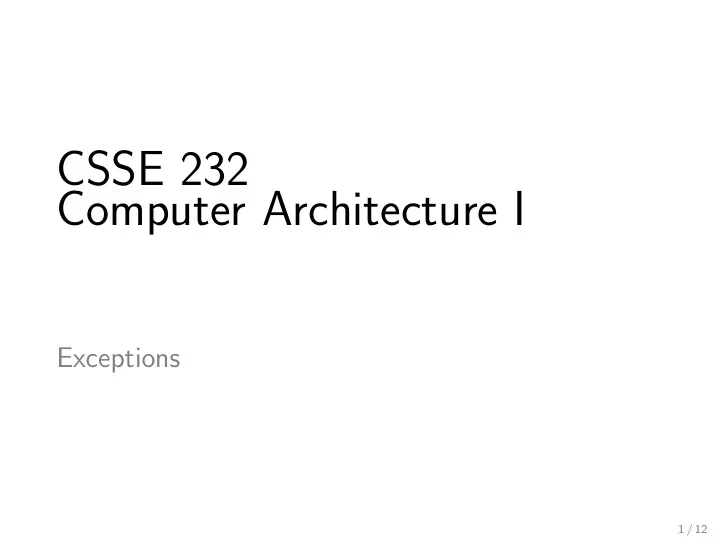

CSSE 232 Computer Architecture I Exceptions 1 / 12
Class Status Reading for today • B.7-8 2 / 12
Outline • Definition • Exception registers • The process • Special exception instructions • Work on lab 3 / 12
Definition What is an exception? • Unexpected events that interrupt normal program flow • Exception and interrupt not the same! • Exception - event from within the processor • Interrupt - event from outside the processor • Are they necessary? • What are the disadvantages of exceptions? 4 / 12
What Exceptions have you seen? Previous programming? • What did they look like? • When did they happen? • How did you solve them? MIPS and SPIM • What did they look like? • When did they happen? • How did you solve them? 5 / 12
Example • Exception generated during program execution • What should happen? 6 / 12
Example • Exception generated during program execution • What should happen? • Should OS continue? 6 / 12
Example • Exception generated during program execution • What should happen? • Should OS continue? • Should program continue running? • Possible ways to handle running program? 6 / 12
Example • Exception generated during program execution • What should happen? • Should OS continue? • Should program continue running? • Possible ways to handle running program? • OS terminates the program • Skip offending instruction, continue • Retry offending instruction, continue 6 / 12
Example • Exception generated during program execution • What should happen? • Should OS continue? • Should program continue running? • Possible ways to handle running program? • OS terminates the program • Skip offending instruction, continue • Retry offending instruction, continue • What does the processor need to continue running the program? 6 / 12
Important Exceptions registers • EPC • Stores address of bad instruction • Status Register • Stores the status of the exception • Exception being handled, ignore subsequent exceptions • Cause Register • Stores cause of exception 7 / 12
Important Exceptions registers Status register $ 12 : Exception Interrupt enable mode User level 15 8 4 1 0 Interrupt mask Cause register $ 13 : 31 15 8 6 2 Branch Pending Exception delay interrupts code 8 / 12
Process • In MIPS, exceptions managed by a System Control Coprocessor (CP0) - a special location on the CPU • Only helps the main processor start exception handling. • Main processor runs the actual handler • Save PC of offending (or interrupted) instruction • In MIPS: Exception Program Counter (EPC) • Save indication of the problem • In MIPS: Cause register • Jump to handler at 8000 00180 • Not the only way to do it. Book will talk about vectored interrupts 9 / 12
Special Instructions • mfc0 • Move from coprocessor 0 • mtc0 • Move to coprocessor 0 • eret • Return from exception (goes to EPC) 10 / 12
Exception Handler • Read cause, transfer to relevant handler • In Handler • Determine action required • If restartable • Take corrective action • use EPC to return to program • Otherwise • Terminate program • Report error using EPC, cause, ? 11 / 12
Work on Lab • Posted on course site 12 / 12
Recommend
More recommend